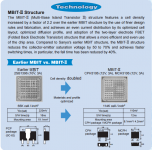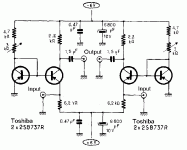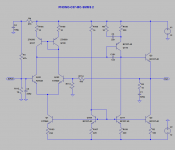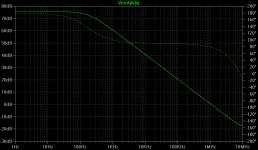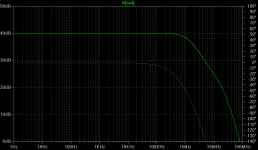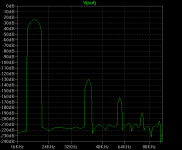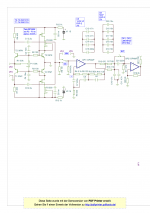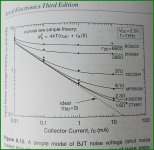Zetex makes a lot alternatives and that is only one.
What do we want for an MC input :
High Hfe will reduce the base current when we want direct coupling at the input.
Linear Hfe over current reduces distortion causes by dynamic gain change.
High early voltage reduces distortion too but of another type.
It is paticular difficult to find a complimentary PNP device that maintains high early voltage at relative high current that is satisfactory to reduce voltage noise.
Low Rbb`. That parameter is also responsible for voltage noise.
Low 1/F corner so that low frequencies are clean of noise.
Other souces like popcorn noise are process based.
Modern processes do usually not have problems with popcorn noise or other chaotic and dynamic noise sources.
What do we want for an MC input :
High Hfe will reduce the base current when we want direct coupling at the input.
Linear Hfe over current reduces distortion causes by dynamic gain change.
High early voltage reduces distortion too but of another type.
It is paticular difficult to find a complimentary PNP device that maintains high early voltage at relative high current that is satisfactory to reduce voltage noise.
Low Rbb`. That parameter is also responsible for voltage noise.
Low 1/F corner so that low frequencies are clean of noise.
Other souces like popcorn noise are process based.
Modern processes do usually not have problems with popcorn noise or other chaotic and dynamic noise sources.
With, BJT's balanced inputs are a way to minimize problems with base currents. Another option could be like they do on the Prepre (Hiraga) make it adjustable. I used to use the Prepre as an inputstage and as I remember it was more than excellent. Maybe time for a revisit.. Like servo the input and folde currents over into a second stage.
Not quite understand what makes the 848/949 nicer than the FZT851/951 pair.
(851/951 are the output devices of Array power amps)
Some time ago a dya member made some noise measurements of ztx849 that is the same that fzt849 and the noise at 10ma was only 0.21nV that is equivalent to a 3 ohms resistor.
http://www.diyaudio.com/forums/parts/168561-some-transistor-voltage-noise-measurements.html
I think that maybe a even lower noise transistor could be the 2SC6017 from ON as the hfe is higher and it uses the sanyo MBIT process ( Multi Base Island Transistor ).
http://www.onsemi.com/pub_link/Collateral/EN8275-D.PDF
Attachments
With, BJT's balanced inputs are a way to minimize problems with base currents. Another option could be like they do on the Prepre (Hiraga) make it adjustable. I used to use the Prepre as an inputstage and as I remember it was more than excellent. Maybe time for a revisit.. Like servo the input and folde currents over into a second stage.
Is this the circuit ?
Attachments
A simpler circuit.
Only use 1 input pair this time, but instead of 10mA per transistor, now it has 30mA per transistor.
This type of transistors have a internal structure equivalent to many transistors in parallel, so i think that there is not much to gain in paralleling more BJT, increase the Ic seems a more simple solution ( at least in the simulation )
)
The RB of the ZTX849 model is 0.025.
second image is the "open" loop gain.
third image is the frequency responce with a 3 ohm source.
edit: added R1 R4 to adjust the input voltage to zero, c4 is not necessary.
the simulated noise is 0.18nV similar to a 2 ohm resistor.
Only use 1 input pair this time, but instead of 10mA per transistor, now it has 30mA per transistor.
This type of transistors have a internal structure equivalent to many transistors in parallel, so i think that there is not much to gain in paralleling more BJT, increase the Ic seems a more simple solution ( at least in the simulation
The RB of the ZTX849 model is 0.025.
second image is the "open" loop gain.
third image is the frequency responce with a 3 ohm source.
edit: added R1 R4 to adjust the input voltage to zero, c4 is not necessary.
the simulated noise is 0.18nV similar to a 2 ohm resistor.
Attachments
Last edited:
Yes sergio, that is the circuit, Sound was excelint. This was the time when my phono section was tubes, LA-Auduio C-3 with stepped attenuators.
Now my phono circuit, is different (Gerhard knows) it uses zetex transistors, high current and is with a floating balanced input. I also did a test with biss transistors, they too were very very good.
Maybe even a bit crispier sounding
I also like your little opamp circuit.
Now my phono circuit, is different (Gerhard knows) it uses zetex transistors, high current and is with a floating balanced input. I also did a test with biss transistors, they too were very very good.
Maybe even a bit crispier sounding
I also like your little opamp circuit.
Last edited:
How do you do the floating power sources? with a rechargeable battery? or have found a better solution?
I´m in a phase of building asymmetric circuits , as they tend to not cancel the pair harmonics so much.
, as they tend to not cancel the pair harmonics so much.
I think I will make a PCB for this circuit, can also serve as a I/V converter for the ES9018 DAC with a 1ohm resistor.
Do you have any recommendation for the circuit?
This is the simulated fft at 20Khz and 1mV input
I´m in a phase of building asymmetric circuits
I think I will make a PCB for this circuit, can also serve as a I/V converter for the ES9018 DAC with a 1ohm resistor.
Do you have any recommendation for the circuit?
This is the simulated fft at 20Khz and 1mV input
Attachments
I have made the floating supply in several ways, at one time I made one with light bulbs and two solar panels, now I do it a lot simpler.... There two ways that both are very good one method is the use a low ripple switcher, another is to suspend the circuit between two current mirrors. (Like I mirror in the currents in the PowerAmp I sent you) the high impedance of the mirrors floats the circuit. With balanced input and matche pairs the input node offset is neglible
I had the Hiraga at the beginning of the 80s.
I made a lot of circuits with the same idea to improve it.
One simple modification is a resistor between the transdiode and the input transistor and an elcap shunt from there to ground. That reduces the noise by 3dB.
I would like to remind you that the distortion in the Hiraga is quite high, no matter how great it sounds.
I made a lot of circuits with the same idea to improve it.
One simple modification is a resistor between the transdiode and the input transistor and an elcap shunt from there to ground. That reduces the noise by 3dB.
I would like to remind you that the distortion in the Hiraga is quite high, no matter how great it sounds.
I have made the floating supply in several ways, at one time I made one with light bulbs and two solar panels, now I do it a lot simpler.... There two ways that both are very good one method is the use a low ripple switcher, another is to suspend the circuit between two current mirrors. (Like I mirror in the currents in the PowerAmp I sent you) the high impedance of the mirrors floats the circuit. With balanced input and matche pairs the input node offset is neglible
I think the idea of using mirrors or CCS are good , it is possible to make them very high impedance and have a very good PSRR , My current DAC I/V is based on that principle too.
I would like to remind you that the distortion in the Hiraga is quite high, no matter how great it sounds.
But the second harmonic is predominant, it is not?
Yes, it is. My version has less second but still more then third because no circuit, even a parrallelsymmetric is perfectly symmetric. It could be trimmed to cancel though.
On the other had a cartridge at cruising speed has already 1% second that adds to the mix.
One other clear advantage of my circuit is 6dB less noise then the Hiraga.
With the transistors shown it is dead quiet to a point where you think the system is not switched on although this transistors are not really super low Rbb´champs. Why that is i have no logical explanation for.
I think it is in the very clean supply.
On the other had a cartridge at cruising speed has already 1% second that adds to the mix.
One other clear advantage of my circuit is 6dB less noise then the Hiraga.
With the transistors shown it is dead quiet to a point where you think the system is not switched on although this transistors are not really super low Rbb´champs. Why that is i have no logical explanation for.
I think it is in the very clean supply.
Some time ago
